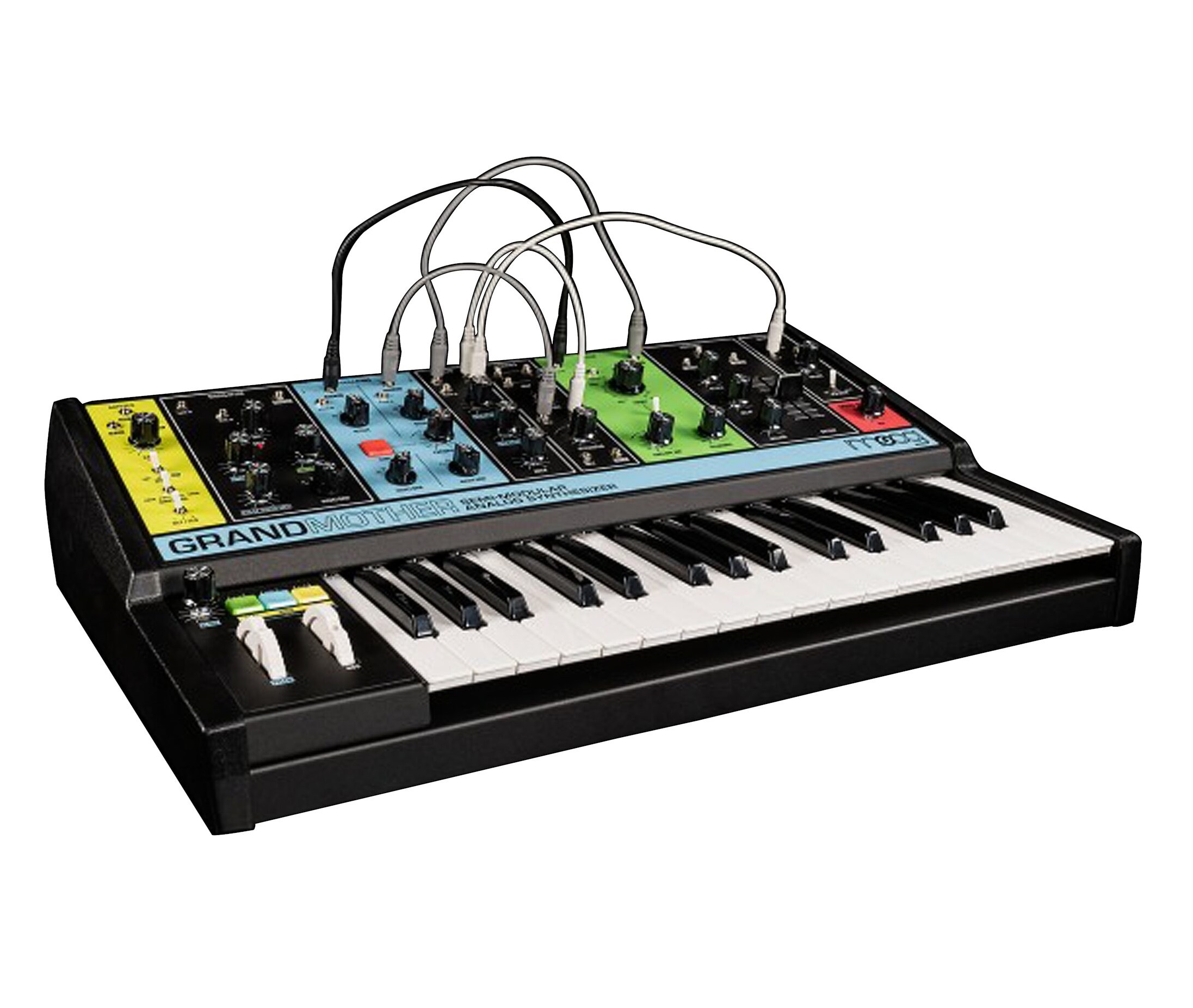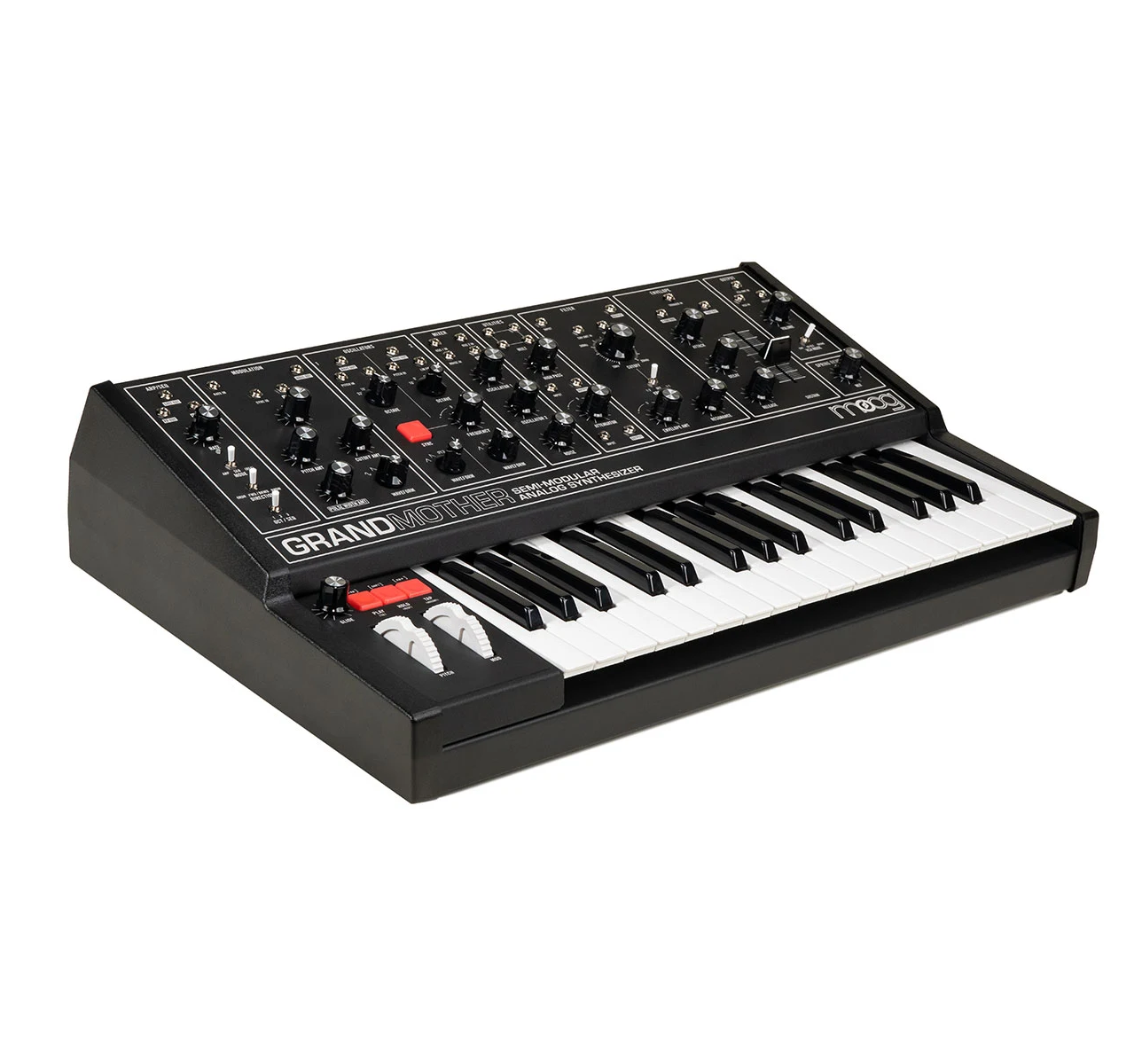Moog Grandmother
Electronic Instruments
America
Between 1901 and present
Video
The Moog Grandmother is a semi-modular analog synthesizer that blends vintage-style sound design with modern modular synthesis flexibility. Released by Moog Music, this synthesizer draws inspiration from classic Moog designs while offering hands-on playability and patching options for both beginners and experienced musicians. The Grandmother is renowned for its warm analog tones, intuitive interface, and robust build, making it a sought-after instrument in electronic music production.
Type of Instrument
The Moog Grandmother is classified as an electronic musical instrument, specifically an analog synthesizer. Unlike traditional acoustic instruments, which rely on physical vibrations to produce sound, the Grandmother generates sound electronically using oscillators, filters, and modulation sources. This places it within the broader category of synthesizers, a family of instruments that emerged in the mid-20th century and have since become integral to numerous musical genres.
History
Origin and Development
The Moog Grandmother originates from North America, specifically the United States. Moog Music, the company responsible for its development, has been a pioneer in electronic musical instruments since the 1960s. The company was founded by Robert Moog, an American engineer whose contributions to synthesizer technology revolutionized modern music.
The Grandmother was introduced in the 21st century, with its official release in 2018. While its design is rooted in the analog synthesizers of the 20th century, particularly those from the 1960s and 1970s, the Grandmother represents a modern take on Moog’s classic sound. It incorporates elements from historic Moog synths while integrating features that cater to contemporary musicians.
Construction
The Grandmother is built with a durable metal and plastic chassis, featuring a 37-note velocity-sensitive keyboard. The control panel is divided into distinct sections, each color-coded for ease of navigation. These sections include oscillators, filters, envelope generators, modulation sources, and a built-in spring reverb.
One of the most distinctive aspects of the Grandmother’s construction is its semi-modular architecture. Unlike fully modular synthesizers, which require patch cables to function, the Grandmother can produce sound without any external connections. However, it also features 32 patch points, allowing users to reroute signals and experiment with modular synthesis. This hybrid design provides versatility, making it accessible to both newcomers and advanced synthesists.
Types of Moog Grandmother Variants
Although the Moog Grandmother does not have multiple types or significantly different models, Moog Music has released special edition color variants. The original model featured a vibrant multicolor design, but Moog later introduced an all-black edition to appeal to users seeking a more understated aesthetic. Despite these visual differences, all versions of the Grandmother share the same internal components and functionality.
Characteristics
The Moog Grandmother is known for its rich analog sound, hands-on control, and flexibility. Some key characteristics include:
Fully Analog Signal Path: Unlike digital synthesizers, the Grandmother produces sound through purely analog circuits, resulting in a warm and dynamic tone.
Semi-Modular Design: It works both as a standalone synthesizer and as part of a larger modular system.
Classic Moog Ladder Filter: The filter section provides deep, resonant bass tones and smooth frequency sweeps.
Built-in Spring Reverb: A rare feature in modern synthesizers, the spring reverb adds vintage character to the sound.
Arpeggiator and Sequencer: These built-in tools allow for complex rhythmic patterns and evolving soundscapes.
Sound Production
The Moog Grandmother is a semi-modular analog synthesizer that produces sound using voltage-controlled oscillators (VCOs), filters (VCFs), and amplifiers (VCAs). It generates rich, warm tones by shaping electrical signals, which can be further modified using its built-in spring reverb, modulation sources, and sequencer. The instrument follows subtractive synthesis principles, where harmonically rich waveforms, such as sawtooth, triangle, and square waves, are shaped by filters and envelopes to create distinct sounds.
The elements work together to create an extensive range of tones, from deep basslines to soaring leads and atmospheric pads.
Playing Methods
The Moog Grandmother offers multiple ways to interact with its sound.
Roles in Music
The Moog Grandmother is used across various musical genres, from electronic and ambient to rock and experimental music. Some common applications include:
Lead Synth Sounds: The expressive filter and warm oscillators make it ideal for solo melodies.
Basslines: Its deep, resonant low end is perfect for electronic and funk basslines.
Sound Effects and Textures: The modular capabilities allow for unique sound design applications.
Live Performance: The intuitive interface makes it a popular choice for live electronic musicians.
Cultural Significance
The Moog Grandmother carries significant cultural weight due to its heritage and influence on synthesizer music. As a Moog instrument, it inherits the legacy of the company that helped shape electronic music since the 1960s.
Moog synthesizers have been used by legendary artists such as Wendy Carlos, Kraftwerk, and Keith Emerson, and the Grandmother continues this tradition by making classic Moog sounds accessible to a new generation. It has become a favorite among modern electronic producers, experimental musicians, and modular synthesis enthusiasts. Additionally, the resurgence of analog synthesizers in the 21st century has made instruments like the Grandmother more popular than ever. As electronic music continues to evolve, the Moog Grandmother remains a vital tool for those seeking a mix of vintage warmth and modern flexibility.
The Moog Grandmother is more than just a synthesizer—it is a bridge between the past and present, offering both nostalgic analog tones and contemporary modular possibilities. Its semi-modular architecture, classic Moog sound, and intuitive design make it an essential instrument for musicians, sound designers, and synthesizer enthusiasts. Whether used for basslines, leads, soundscapes, or experimental synthesis, the Grandmother holds a unique place in the world of electronic music, cementing its status as a modern classic.
FAQ
What is the history of the Moog Grandmother?
The Moog Grandmother was released in 2018 by Moog Music. It draws inspiration from vintage Moog modular synths, offering a semi-modular analog design. The instrument embodies Moog's legacy while being accessible to both beginners and professionals. It became popular for its classic Moog sound and hands-on workflow.
What is the origin of the Moog Grandmother's design?
The design of the Moog Grandmother is rooted in Moog’s early modular systems from the 1960s and 70s. It combines classic Moog circuit designs with modern usability. The vibrant color scheme pays tribute to Moog’s early educational synthesizers. Despite its vintage roots, it offers contemporary features like MIDI and arpeggiation.
What are the key sounds of the Moog Grandmother?
The Moog Grandmother produces warm, rich analog tones with a classic Moog character. It features a built-in spring reverb, fat oscillators, and a ladder filter for deep bass and soaring leads. Its patchable architecture allows for modular-style sound exploration. The synth excels in everything from smooth pads to aggressive, experimental textures.
 Links
Links
References
Other Instrument
Categories



















